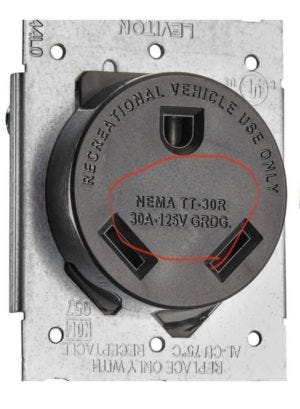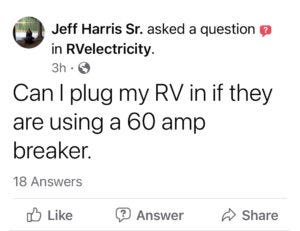Dear Mike,
I had a terrible situation that may be an important lesson to teach your RVelectricity™ readers.
My wife and I drove our Newmar Ventana from Clovis. California, to Aurora, Colorado, to a reunion with 4 fellow U.S. Army Vietnam Combat Soldiers in July. Upon arriving to my friend’s home, he replaced a 220 welding outlet plug to a 30-amp plug, so I could plug in to run our RV electric. Having a 50-amp service, I used a 50-amp to 30-amp dogbone adapter and plugged in. Not realizing that was dangerous it blew out the controller, where the electric comes into our motorhome, pumping in about 100 amps too much electricity!
I obtained a new power box for $140 and a mobile RV electric tech responded and took out the ruined box and components, and installed the new one for $200. The nice Technician told us we could have had so much more damage to electrical boards, and wiring, in our motorhome and we were lucky that did not occur due to that overload!
I purchased an internal EMS/surge protector, and am having that installed to hopefully avoid future electrical problems!
I did not know the welding outlet was something not to use for RV electric, but sure learned the hard way!!!😊 —Brian “Doc” Burry
Dear Doc,
Thanks for your note. Yup, there are a lot of residential electricians and DIYers who still don’t understand that a 30-amp RV outlet is wired as single-pole/120 volts. So they put in a new outlet wired as 2-pole/240 volts. By using a 30-amp to 50-amp dogbone adapter you injected 240 volts into both legs of your 50-amp shore power connection.
You were very lucky to get away with that little amount of damage. Usually it costs 10 times as much to fix that kind of mistake. —Mike
And from my RVelectricity Facebook group…
Dear Mike,
Okay, a different problem with a welding outlet, but still dangerous for an RV. In this case it’s possible that this outlet was an old welding receptacle that was modernized with a 50-amp NEMA 14-50 receptacle for an RV. Or possibly it’s a new 14-50 outlet installed with a 60-amp breaker for a Tesla home charger, neither of which required a neutral conductor. The only way to know for sure is to turn off the power and get a look inside of the receptacle itself. Please find someone qualified to do this for you if you’re not trained in wiring safety.
While a welder or Tesla home charger doesn’t require a neutral to operate safely, plugging your 50-amp RV shore power cord into this kind of connection won’t allow the 240/120-volt split-phase service to divide evenly into 120/120 volts, with dire consequences.
Why are outlets so confusing?
Take a look at this NEMA chart below for the plethora of possible outlets in the USA alone. Unless an electrician is familiar with these various types, and knows how to meter the service properly, it’s easy to get confused. That’s why I get emails like this every week. That’s another reason why I always recommend a good EMS/Advanced Surge Protector that will shut off power to your RV if it’s plugged into a miswired outlet that could damage your electrical system.
Now you can see why you should hire a licensed electrician to hook up any RV outlets, and make sure they meter it properly. Never plug your RV into any newly installed outlet without carefully metering it yourself first. Here’s what to look for…
Yup, wiring can get a bit confusing in the USA. It’s actually much simpler in the UK, as they have fewer receptacle possibilities.
Let’s play safe out there (especially in the USA)…. Mike
Mike Sokol is an electrical and professional sound expert with 50+ years in the industry. His book on RV Electrical Safety is available at Amazon.









Camco has a Power Grip - Circuit Analyzer - 30Amp Plug-Type 125V
Item #: 55310, which is like many of the very inexpensive imported Analyzer/Surge Protectors. Low price, no mention of overvoltage at 132v.
Camco has "Voltage Protector" models, which state they handle over 132v.
Testing is great, but best to use your "power of the press" to make it clear to RVers, many surge protectors will not protect you from brown out or overvoltage. They only protect from a rapid surge, that is considerably above 240v.
Progressive in Southwire RV EMS and surge protectors handle 240 volt over protection. Has anybody tested the inexpensive RV surge protectors, which may not clamp until 300 or 400 volts.